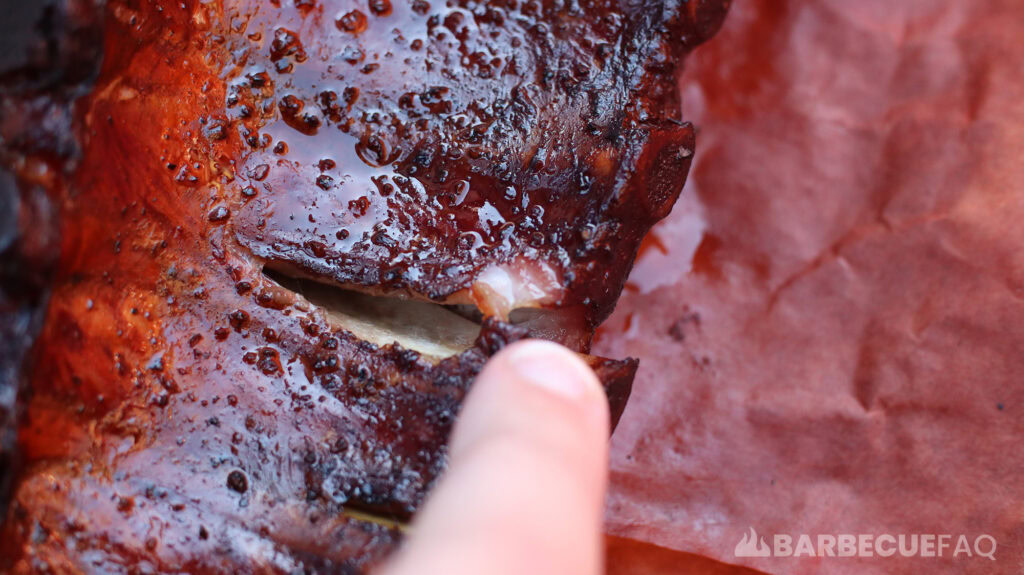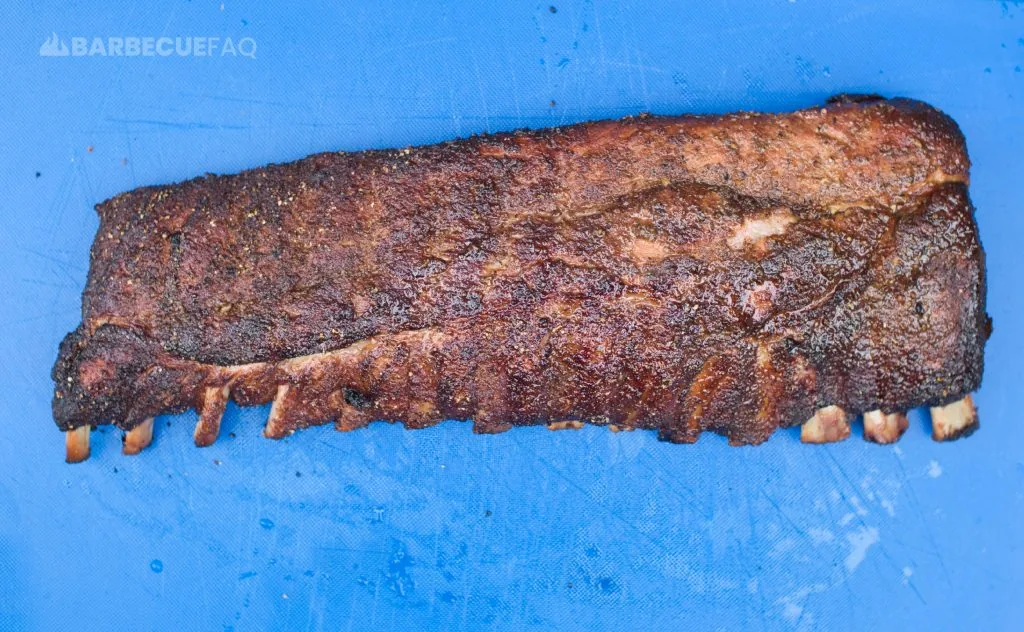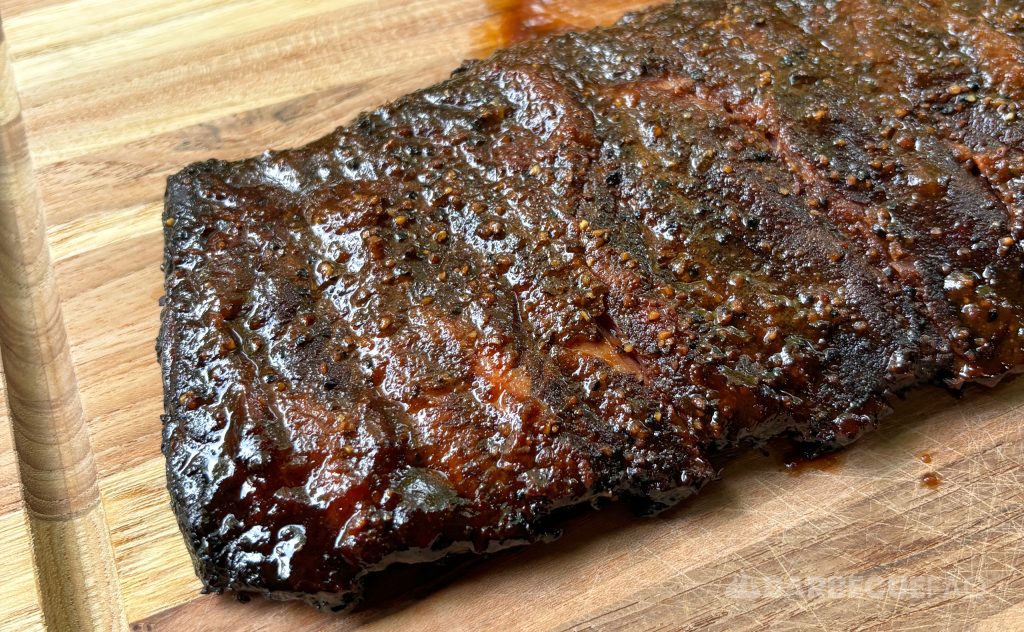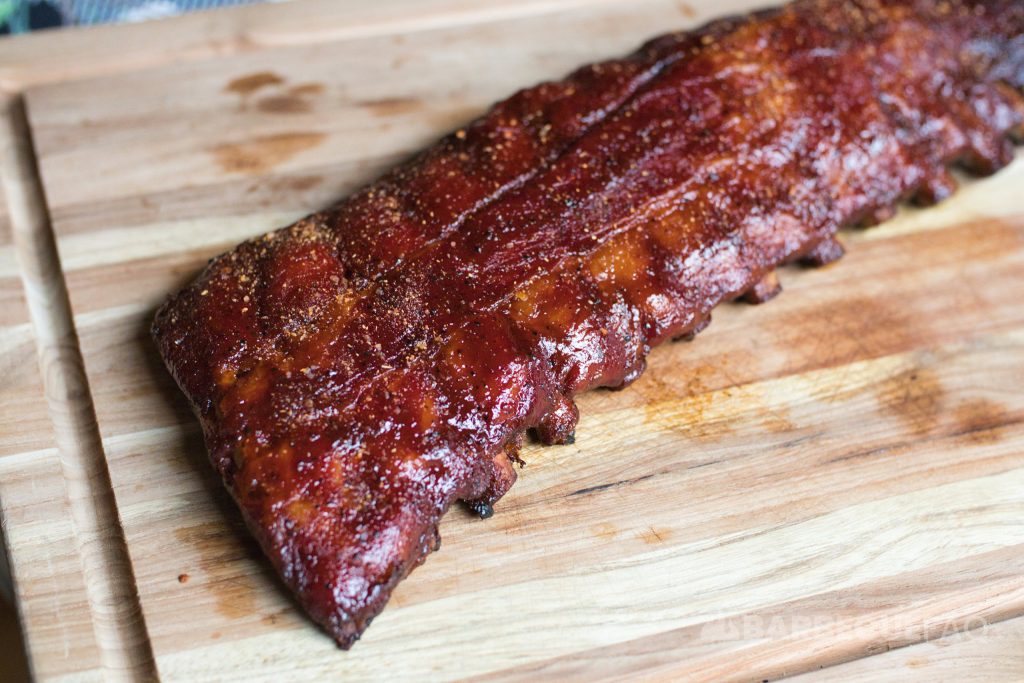If you like bite off the bone ribs:
If you like fall off the bone ribs:
- After smoking, cook the ribs wrapped until the internal temperature is 212-213F internal.
I also think Time, Temperature, and “Pull-back” from the bone are bad guides most of the time.
Grab Some Tongs and Grab Your Ribs at About the 5th Rib
Allow the ribs to bend at this rib.
If they bend at a 45 degree angle, they’ll likely be bite off the bone tender.

Below are the same ribs at 174F internal.
They don’t bend at all BUT the rub has set and they have taken on enough smoke, telling me it’s time to wrap.

Combine this Test with Other Tests: Probe Tenderness & Tear Test
Take your probe or a toothpick and poke between the bones.
If it glides in and out with no resistance, they’re done.
You can equate it to taking a probe and pushing it through a jar of peanut butter or softened butter.
ACTUALLY do this at Home! This sensation is what it feels like.
You can also flip the ribs over to the bone side, grab a bone and tear the bone slightly.

If no meat is attached to the tear, it means they’re bite off the bone tender.
Pull-back from the Bone Means Diddly Squat
The pull-back occurs because meat shrinks when cooked.
BUT bones pulling back or not depends more on the rib rack than anything – some will pull back more than others – some won’t at all.
For example, these are done:

So are these:

So are these:

That’s 3 different types of ribs that are all tender and are ready to rest.
Some have more bone pull-back than others.
This is All good for Pork Ribs but What About Beef Ribs?
Use probe tenderness.
Just take you probe and probe into the meat. If it glides through with ZERO effort and no resistance, they’re done.

Do the same for beef back ribs too.
Beef ribs will have so much fat and collagen that they won’t dry out like a pork rib can.
Typical finishing temperatures are around 200F+.
Same deal here too – bone pullback means little to nothing.
What About 321, 221, Time and Temperature?
Methods like 321 and 221 are OK but:
- The ribs are often not smoky enough.
- I don’t like fall off the bone ribs or mushy meat.
- I prefer simple ribs (salt, pepper, garlic) as apposed to sugar-heavy wraps.
I’m not you though, if you like ribs done this way, do it.
If I know someone likes fall off the bone ribs then 321 with an internal temperature of 212-213F ensures the bones will fall off.
What Does Dylan Like Then?
Usually I like around 4-5 hours of smoke @ 225F – 250F and then 45-60+ minutes wrapped in foil or paper to soften the bark and speed the cook time.
Then checking for tenderness I’ll bend the ribs and tear near a bone – if both of these pass, I know they’re done how I like.
Generally, ribs will finish at around ~195-205F internal.





5 comments
Steve M.
The bend and twist I’ll definitely use the next cook, as my most recent beef back rib cook was a mystery. Foiled at 175 degrees in foil for additional 1-1/2 hours. Bones were protruding quite a bit and they temped at 206 degrees. However after a rest and taste test they weren’t done???? How can that be? Not to mention the foil wrap took all the flavor away from these ribs…I just don’t get that cook!!
Dylan Clay
I’ve had the above happen a number of times over the years – especially when relying on time or internal temperature. In my opinion, the best way to tell is with the bend test. If you’re a fan of bite off the bone ribs, the bend test is a surefire way to determine when they’re tender.
Victor A.
Thanks for the explanation of what goes on with the ribs while cooking. I also felt the 3-2-1 time method left a lot to be desired. I do have a question regarding temperature and “doneness.” A few times I’ve had ribs that were at or above temperature (say 207-212F) but they weren’t exactly probe tender. At that point I was afraid they were possibly over cooked and pulled them. Is it correct to assume that even if they are reaching temps above the target, that leaving them longer would still make them more tender, or would it have the opposite effect?
Dylan Clay
Hey Victor!
So typical finish temperatures are usually around 195 – 205F. However, it’s like I said above, ” If you were to temperature probe the ribs and they said 198, but they didn’t feel probe tender, they are not done.” The issue with higher finishing temperatures is that you’re also pushing tons of moisture out of the meat; Something like ribs have way less intramuscular fat than something like brisket. Baby backs are also way leaner than spares and will finish much faster.
Just to confirm a few things, what type of ribs were they? I’m assuming a full rack of spare ribs at those temperatures; Where were you probing the meat to confirm tenderness? The meat between the bones or cartilage/sternum above the meat? What temperature probe do you use and is it accurate (confirmed via a ice water bath and boiling water)? When you pulled the meat and ate the ribs, did you feel like they weren’t tender to your liking still?
Just to note, 207+ isn’t unheard of for ribs. My advice is still the above though – you should always go based off of probe tenderness. A probe inserted in the meat between the bones should glide through effortlessly – the common adage is “like going through soft butter.”
Victor A.
Thanks for the reply. The ribs were St Louis cut. On a pellet smoker at 275 until they reached 165f (a little over 2 hrs). Wrapped them in heavy duty foil with some butter, brown sugar, and honey. After about 1 1/2 hrs, they were temping around 207-212f depending on the spot.
When I probed them for temp (in between the bones), they had a little resistance to them. More like probing cold butter rather than warm butter. I used a quick read thermometer. An off-brand from Amazon but I did verify the accuracy with boiling and ice water.
I ended up saucing them and leaving them on for another 15 minutes for the sauce to set. I didn’t notice any difference in tenderness when probing them once the sauce was set.
They weren’t bad by any means. But I knew they could be a bit more tender and was curious if there were any missteps and/or if leaving them longer would have helped or hindered the tenderness.